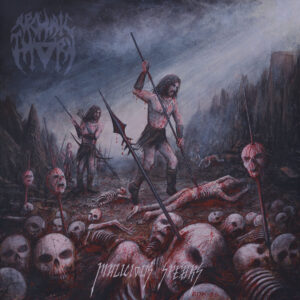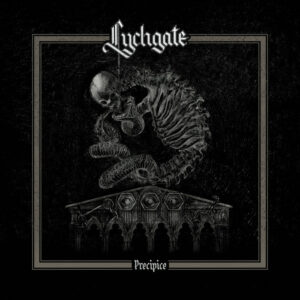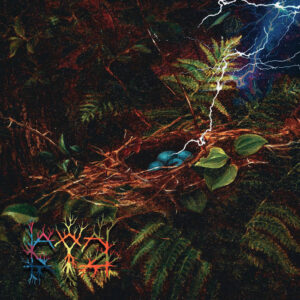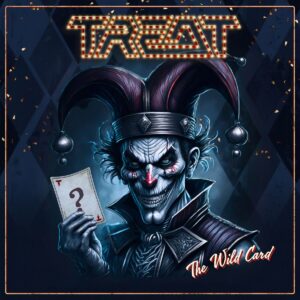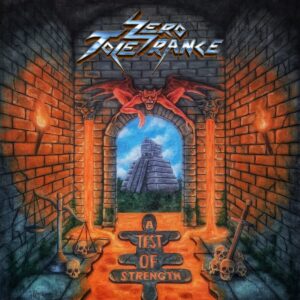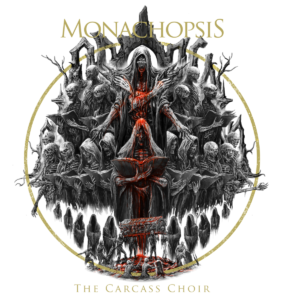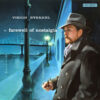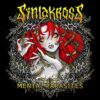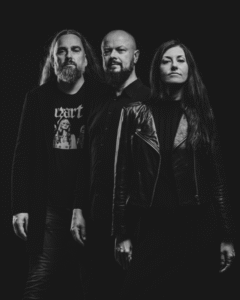THRASH METAL - An Analysis By Dorothy Cheng
•
June 14, 2013
1983: The Beginning of the End
No, 1983 is not a piece of sci-fi spoof literature. It is not somebody's locker combination. And no, it's not my birth year either. What it is, is the year which would mark the history of heavy metal music forever, a year that as uneventful as it was in the global sphere, sparked something in the music industry ' a spark of which had its origins in the many basements of low to middle income homes, with a gunpowder trail that dates back decades through wars and cultural revolutions and social movements ' because that's what it takes to birth a music so wonderful and true, so aberrant yet loved, so classic yet so innovative, and so outcast yet instantly relatable and massively popular. That's what it takes to make Thrash Metal.
Metallica: Big fans of trash and Thrash.
Flashback:
In 1974, Queen veered very slightly off its usual path of theatrical classic rock music and produced "Stone Cold Crazy". The track, though only on a rather small scale, managed to blow stoners, hippies, and British lords out of their underpants. The Rajahs from which the mighty Mercury descends from shrivelled up in the pure essence of that! what is that, though?
What is that quality in Stone Cold Crazy that drives people well, stone cold crazy?
Fast forward a year and the fathers of heavy metal music, being the gods and creators they are, fathered a new song, and through its cult influence, started the course of everything that would become Thrash Metal.
These fathers I speak of are of course, Black Sabbath. They unleashed Symptom of the Universe, oblivious to the lasting effect that song will come to have.
The 70s: Rock bands like Black Sabbath and Queen managed to bring some coherence to a time that would otherwise only be remembered for things we would rather forget
Punk and NWOBHM:
Within the same era, several branches of rock music managed to explode at relatively the same time, in relatively the same geographical region: the United Kingdom. One of them was punk rock.
There's always been a quality about punk that draws the most rebellious, downtrodden, and misunderstood youth into its crushing arms. Is it the frantic beat? The chaotic guitars? Or the lyrics: screeched and wailed and intentionally poorly sung ' denouncing society, normalcy, rigidity ' criminalising perfection and exhorting the opposite.
Unsurprisingly, a mass underground following develops. People who were into the most decadent and debauched trends were naturally drawn to the allure of a music that resented all that was normal. The fashion was outrageous, the lyrics controversial, the movement wildly popular with the youth and unpopular to the authorities. With that kind of media fodder cropping up here and there, punk bands exploded with the negative attention that was shone on them and became the defining marker for that decade's musical history.
And how did mainstream rock music of the 70's respond?
First, it is important to understand which bands fell under the banner of mainstream rock music (all of which were precursors of Heavy Metal or in the case of bands like Black Sabbath, one of the first Heavy Metal bands) at the time. Was it Deep Purple? Was it Led Zeppelin? Black Sabbath? The Who? Pink Floyd? Most of these bands were not referred to by their 'proper subgenre' at this time. Pulled together, they very generally represented the top of the heap of classic rock/hard rock bands at the time, whose talents lay in filling arenas and impregnating groupies. Of course, they could only do all this because their music was so influential, making them some of the biggest bands in rock music ever.
It is largely agreed that bands such as these either completely ignored punk, or found it revolting for its lack of taste. For all that Iron Maiden has contributed to the beginnings of Thrash Metal, its founding member and bassist Steve Harris has a notorious tendency for hating on the music of his spiky haired countrymen. Metalheads of the time too, couldn't care less about punk music, and the natural tensions that brewed between the two fanbases teetered on the border between outright hostility and total indifference.
Punk's influence was not so easily avoided, however. Sharing the British stage with many of the aforementioned big bands in rock music, punk could only head in one direction: and that was to become so prominent within the British music scene that future British bands will inadvertently pick up those influences and create a whole new idea of rock music.
With the term 'heavy metal' just starting to gain momentum with the vernacular of the industry's top dogs, the next few bands that formed during the mid to late 70s who ended up drawing inspiration from the rock titans like Zeppelin and Sabbath but also borrowed the attitude, energy, and speed of punk music were an initial quiz to the industry.
With more attitude, toughness and grit but also with a little less jazz and blues, British bands such as Iron Maiden, Judas Priest, Motorhead, Diamond Head, Saxon, Tygers of Pan Tang (just to name the popular ones), much like the bands of the punk scene, exploded underground. Kids were lining up to get into basements to hear other kids wail into mikes in perfect pitch, murder guitar solos, blaze through bass lines, and holistically incorporate a drumming style involving the double bass drums that were so inciting and exciting that 'headbanging', a phenomenon that was previously not completely integral to rock music, suddenly became a staple of all shows.
From their underground status, fans of the heavy metal calibre helped propel such bands, who were later identified as being part of the 'NWOBHM' movement, into national arenas and luxury jets for destination: world tours. Through the efforts of zealous fans and the production of some of heavy metal music's best albums during this era, NWOBHM dominated the early to mid 80's metal music scene, becoming the defining force and arguably, the most widely loved movement in heavy metal music by both Metalheads (traditional and extreme) and non-Metalheads (posers and critics included).
Trouble in the West:
Across the Atlantic, the punk movement was just a little slower to gain momentum in the United States. But that also meant that its decline would be delayed. With the Dead Kennedys, the Ramones, the New York Dolls, and the Misfits incorporating urban grit with criticism of traditional American values, the movement in the US while less prominent in comparison to the British scene, was also a little more enduring and endearing to its local fan base.
However, the insatiable appetite of a society that was growing only more frustrated with their everyday lives what with the tumultuous events and cultural transformation of America in the 70s and 80s, the punk genre soon evolved into something more in the basements of disenfranchised American youth.
The several resulting subgenres of punk went on to systematically destroy musical norms in the United States first and then Britain all the way into the 80's, culminating of course, with that sweet, pretty little gem we like to call Hardcore Punk that emerged in the late 70's.
American youth, just like all youth, aside from idolising the larger-than-life arena gods and talent warehouses that were the NWOBHM bands, also needed something more relatable, casual, and controversial to fuel their musically adventurous side ' three characteristics that were easily found in Hardcore Punk.
More abrasive, aggressive, and yes, violent than traditional punk rock, the hardcore movement managed to draw the positive attention of those in the metal community who previously so passionately dissed its predecessor, punk rock. Hardcore punk had that extra quality about it that appealed to the emotions of all forms 'rockers' during those confusing times, making it impossible to ignore.
While the fantasies of Hardcore Punk and Heavy Metal didn't necessarily mix, youth at the time were being exposed to two different, yet not so dissimilar musical revolutions. And when they set out to pick up a guitar to realise their dreams of being big arena regulars as well, the two genres that previously had a relevantly hostile history, came together as one and birthed one of heavy metal's most popular, influential, and important subgenres ever.
Black Flag: Just being influential and shit
80's Angst:
Angst was overflowing in the 80s. Frustrations were being pushed to a limit, begging to be unleashed, and peace was just a façade what with the firm, conservative, and highly capitalistic rule of the Republican government in the US and the doom-and-gloom looming threat of Communism and nuclear war.
In popular culture however, the 80s was the time of our lives. MTV, Hollywood, the prominence of macho patriarchy, social modernism countered with increased conservatism, and the gross wealth of the few versus the unmet needs of the many produced some unusual manifestations of angst that permeated in the ever-present tensions of society.
Absolute debauchery and the complete disregard of values loaned notoriety to rock music during this time. Metal music was becoming increasingly popular and mainstream pop audiences were soon assimilating themselves into the pit, easily disguised by donning the archetypal Metal 'do of "leather and lace". Glam Metal, more accessible and listenable than the NWOBHM bands, came to the forefront and in all its glory, swept the music scene of the 80s.
Significantly dumbed down to have a broader appeal, Glam Metal thrived solely on the attitude of the rockers who made up the scene. The musical unity at this point was at its peak, with nearly every single person on the street sporting long, unkempt hair and parading the devil horns every chance they get.
But with every popular movement, there will always be a small minority of marginalised outcasts alienated by populist attitudes and shallow herd mentality. They would revolt in a way that Glam Metal could never answer to ' they were too quick to avoid, too sharp to counter, and too extreme to ignore, resulting in a new form of music production that was more crisp and refined and had more quality yet carried a candour of primate, real, and natural aggression.
Glam Metal clearly wasn't enough to satiate and subdue all that 80's angst and as Newton said, every action will be met with an equal and opposite action.
80s phenomena: Inadequate yet instrumental, as guy number 1 in picture 2 is trying to demonstrate.
Metal Massacre:
So came Thrash Metal. This is where 1983 comes into the spotlight again. But before we get to that date, we need to rewind two years and set our sights on a young, entrepreneurial individual who helped kickstart the careers of many underground bands.
If god had a creator, his name would be Brian.
In 1982, heavy metal devotee Brian Slagel did a noble thing and released Metal Massacre I, a compilation album of unsigned, underground metal acts. This first pressing featured 10 tracks, and by god, would you know it, the last track was by a quartet printed as "Mettallica" *cue forced coughs* with their offering, "Hit the Lights".
Inconspicuous name, isn't it - especially for the breakthrough song of a band that would soon come to dominate the entire Metal scene of the 80s and even the 90s.
And Metallica wasn't the only one. Some of Thrash Metal's biggest names had breaks through the Metal Massacre compilations, including Slayer, Overkill, and Armored Saint. That's half of the future Big Four represented there already.
In addition, these bands already had prior material before going on their Metal Massacre crusades. Metallica had several demos, the most popular of which ended up being "No Life Till Leather", recorded in 1982. Dave Mustaine was involved in the recording of the demo and wrote some of its most crucial songs. After splitting from Metallica, he went on with a vengeance and formed Megadeth, one of the Big Four's most widely-praised, critically acclaimed and technically revered bands.
How does this lead up to 1983? Well, Metallica became the first band within the scene at the time to release an album that was instantly identifiable and recognisable as being different from anything that existed at the time (at least according to popular consensus ' there is still much debate). With Kill 'Em All, Metallica propelled the world of the underground scene at that time to new ecstatic fronts, with each band hopping eagerly onto the bandwagon of speed, brutality, and heavy riffing. Soon, bands began competing against each other to see who could produce the fastest solos, heaviest riffs, and most explosive drumming, creating a thriving scene of emerging bands and raw talent. This prompted many dissenters of the L.A. glam scene, attracted to the stunning virtuosity and ferocious spirit that define the musicality of thrash, to embark on a massive inquiry into the underground music scene.
So that's the history and the beginning of the spread of heavy metal but what does it really take to make Thrash Metal? What has been the catalyst that has enabled Thrash bands to step onto the world stage and receive critical acclaim? Is it really just angst and anger and disenfranchisement topped off with some talent? Is it really that simple? Or should we look to the individuals who helped mold every aspect of Thrash Metal ' visionaries and misfits who by the true creed of Metal, never ceased to make beautiful music?
Just by analysing the works of the Big Four to make things simple, there are immediately four different kinds of Thrash Metal that can be identified, and this is just by looking at four bands. Slayer would be the Thrash band that has incorporated, and likely birthed, Death Metal. Death Metal, featuring similar aspects of Thrash that have been brutalised and made heavier, bring an extra touch of intense aggressiveness to Slayer's already super intense music. Megadeth would be the band that thrives on technicality and musical sophistication, spearheading the generation of sensitive music-men who wanted to rock out yet keep their stylistic integrity. Anthrax would be the fun-loving, genre-crossing, flat-out Metal dudes who can rock any stage and because of their New York origins, brought urban rebellion to a whole new level. And finally Metallica, the most successful and famous of the four, would be the Thrash band that relies on simplicity and occasionally, Hard Rock influences to propel Thrash Metal to a more mainstream sensibility.
But of course, all Thrash bands, including the four listed above, have one thing in common: attitude. If it weren't for this "attitude", Thrash bands would not be able to connect with their fans in the phenomenal way that they have. Devil may care individuality topped off with fun-loving machismo and an almost pseudo-punk rebelliousness, Thrash bands were widely loved by their fans both for their onstage personas and their off-stage realness.
This just goes to show how amazingly versatile Thrash Metal can be, and this is largely due to its colourful history that involved subgenres across oceans intertwining, doused with musical catalysts here and there such as the double bass drums and low-register riffing, and completed and complemented by the personalities who made up the scene ' disenfranchised, angry, rebellious youth who wanted nothing but to break away from the Glam scene.
Thrash Metal is the result of talented people who wanted nothing more but to create and be themselves. It is a testimony to human ingenuity and spirit, built on the wilful personalities of true musicians who believed and achieved. Its foundation lies on the belief that the complex beauty of this music is found by understanding that perfection - is not always perfect. It is what is felt in the moment ' it is the experience and the emotions that the music invokes that makes you feel whole ' and that's what the pit is for.
The Big Four: Not very sure what to do with their hands when they aren't smashing instruments, holding beers, or making the devil horns.
More results...
